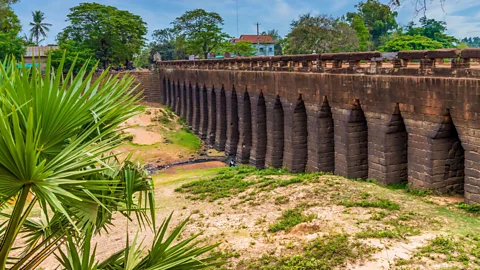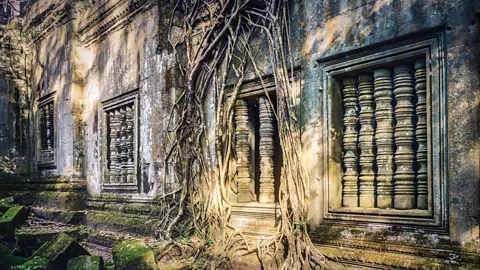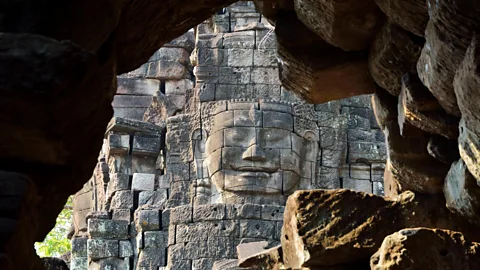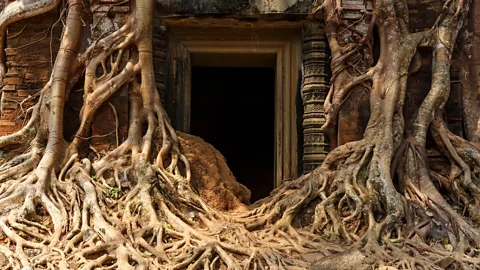Filled with ancient bridges, little-known temples and plenty of off-road adventure, Cambodia’s East Royal Road reveals a unique side of the illustrious Khmer Empire.
I set off in a minivan the morning of my birthday and ended up on the back of a dirt bike clutching a Cambodian man I’d never met before.
At 07:00, I had alighted from the wrought iron lift at Raffles Grand Hotel d’Angkor Siem Riep, much as I imagined Jackie Kennedy had done during her visit here in 1967, and met my guide, Pheakdey “Dey” Sieng from the tour operator About Asia. I’d come to Siem Reap to explore the East Royal Road, a 100km route that links the ancient temples of Angkor Wat, Beng Mealea and Preah Khan Kompong Svay. The Khmer Empire, which ruled much of Southeast Asia from 802-1431 CE, is famed for its temples, but much of its power came from the 3,000km road system stretching from its historical capital, Angkor, to the far reaches of its realm in modern-day Thailand, Vietnam, Laos and Myanmar.
THE OPEN ROAD
While there were five royal roads that linked the capital with its provincial cities, the East Royal Road not only has the largest collection of intact Khmer infrastructure (including bridges, ponds, walls and embankments), but also resthouse temples that aren’t found on other roads where pilgrims could eat, pray and sleep. The road was also used to transport the stones used to build the Khmer temples and the iron that was made into weaponry to defend them. The Khmer were known for their sophisticated irrigation systems, and the road is lined with ancient laterite bridges – most of which are still in use – that cross over rivers and streams.
The route is considered a classic road trip for dirt bikers and temple enthusiasts alike, and just before I arrived, Prime Minister Hun Manet nominated Beng Mealea and Preah Khan for inclusion as Unesco World Heritage sites. With interest in these sites expected to grow in the coming years, I wanted to see them while they were still under the radar.

There was only one problem: the heat was searing. Travellers are advised against coming to Siem Reap in April as it’s hotter than Hades, and this particular week, there was a heatwave with temperatures reaching topping 40C, with a UV index of 12 on a scale of 1-11+.
Dey’s plan was to visit Preah Khan first and then continue to Beng Mealea before returning to Siem Reap, leaving Angkor for another day. Departing Siem Reap on the ancient earthen road (now largely tracing the paved Highway 6), our first stop, Kampong Kdei, was an 86m bridge supported by 21 arches built during the 12th-Century reign of Jayavarman VII, the greatest and most ambitious Khmer ruler. The rust-coloured bridge, which graces Cambodia’s 5,000 Riel banknote, has striking balustrades in the form of a nine-headed naga: the mythical half-human, half-serpent representing water and fertility that’s popular in Khmer artwork.
“Welcome to free massage road,” Dey said, as we turned onto a bumpy, dirt path. I wondered what kind of massages he gets, since I felt like I was being dropped repeatedly from a second-floor window. Still an hour from Preah Khan and now off the highway, a more bucolic view of Cambodia emerged. Cement homes were replaced by wooden houses on stilts. A baby calf and her mother ambled across the dusty road and naked toddlers took a break from roughhousing to smile and wave. According to Dey, the villagers are primarily farmers who grow cashews, cassava and rice.
Bones thoroughly rattled, we arrived at Preah Khan. Unlike Angkor Wat which welcomes thousands of visitors a day, few travellers make it to Preah Khan, and as a fellow tourist and I smiled at each other in passing, it felt as if we were in on a secret.

Dey explained that this was the empire’s most looted temple, having been plundered by French explorers in the 19th Century and locals in the 20th. In places, the temple looked like a giant game of Jenga, but it was also a menagerie filled with carved three-headed stone swans, garudas (divine birds), elephants and nagas. We stopped at the restored 9.5m-high statue, Preah Chahtomukh, carved with four smiling Buddhas facing each cardinal direction. The sublime sight of the serene, enigmatic faces carved into massive stone towers awed me, and I could see why fellow travellers call them “the Mona Lisas of Southeast Asia”.
More like this:
• The Overseas Highway: The US’ ‘floating’ highway
• A road trip through the roof of the Americas
• The road that’s the ‘Eighth World Wonder’
Lunch was a delicious meal of rice and dried fish in a thatched hut at a local restaurant. “This stretch would be better on a dirt bike,” Dey said, before explaining that the road from Preah Khan to the village of Khvav can only be navigated by off-road motorcycles and oxcarts. Fortunately, he just happened to know two men who’d be happy to take us. I thought of “the birthday effect”, which says that, statistically speaking, your risk of dying is higher on or near your birthday. Riding on the back of a dirt bike along a dusty path rutted by oxcarts in sweltering weather probably wouldn’t help my odds.
My dirt bike driver, Mr Cheat, looked concerned as I clambered onto the back of his bike and clenched the grab rail. Dey, who’d been quite serious, broke into a mischievous grin. The engine sputtered and we were off. Careening through the jungle, we dodged trenches and low-hanging tree boughs. We whizzed with exhilaration past forests, fields and the occasional tractor on tightly packed clay pathways before stopping on the side of the road to wander rarely seen ruins.
The road from Preah Khan to Beng Mealea is lined with rest stops called “firehouses” and the slightly larger resthouse temples. Historians disagree on whether either of these stopping places were religious, secular or both, and because of their inaccessibility, little research has been done on them to date.

We stopped at Sopheap Tbong which mirrors the design of all resthouses: an outer wall with a large gate leading to a central hallway flanked by two galleries. Peering through askew windows into a narrow room, I imagined ancient travellers and pilgrims seeking reprieve from their long journeys through the vast Khmer Empire. Since it was believed that the average Khmer traveller could cover 30km per day, these resthouses were placed 15km apart to allow for mid-day and evening stops.
Prasat Pram, another resthouse, is mostly an array of vine-strangled rocks, but a detached window revealed the carved pillars that served as Khmer window blinds. While I cursed the temperature, I was grateful that the roads were dry, as navigating through wet oxcart ruts would have been treacherous. Before we drove off, I asked Dey why we hadn’t seen any oxcarts. He replied, “It’s too hot for the ox.”
Back on the bike, I gripped Mr Cheat’s shoulders. “One more temple”, Dey said. Twenty minutes later, I was lumbering over the fallen laterite blocks of the ruined fire shrine, Prasat Ta En, before pausing to take a breath. This was a reststop after all. Leaves rustled and I inhaled the herbaceous fragrance of the trees as the sun peeked through the forest canopy. Without intervention, this site will fade from memory. Except for a few jutting pieces of stone, nature’s reclamation was nearly complete.
We then drove to our final bridge, Spean Ta Ong, which offered a welcome respite from the rutted roads. At more than 70m long, the ornately carved bridge is as impressive as it is beautiful, especially with its naga balustrades glowing burnt sienna in the late afternoon light.

Pulling into Khvav, my 30km dirt bike adventure ended. I bid Mr Cheat farewell and climbed back into my air-conditioned chariot with Dey. We were 20km from Bang Mealea, which closed in 15 minutes. We pulled up late, but after Dey slipped $5 to a guide enjoying an after-hours beer, we entered Beng Mealea and had it all to ourselves.
Constructed at the same time as Angkor Wat, many believe Beng Mealea was a prototype for the capitol. The temple is mysterious, romantic and virtually untouched. Silk cotton trees entwine the stone ruins, their roots splaying across the ground like the greedy claws of a giant lizard, while menacing strangler figs look like they’re trying to burrow into the earth to reclaim their rightful place in the underworld.
Littered about the grounds are large piles of sandstone blocks, many decorated with intricate carvings. We followed winding wooden walkways through the ruins (which, it turns out, were built for the set of the 2004 film Two Brothers, starring Guy Pierce). Amidst the rubble on a wall, there was a moss-covered masterpiece: the Churning of the Ocean of Milk, a scene from a Hindu legend depicting a tug-of-war between gods and demons for the elixir of immortality.
After an hour, we were back in Siem Reap and stopped by the offices of About Asia where, in my mud-spattered state, I chatted with Silen Truy, one of Siem Reap’s few female guides. When I asked her why she wasn’t my guide, she laughed and said, “The dirt bike. That’s man stuff.”
I returned to Raffles looking more like Bear Grylls than Jackie Kennedy. Thorns jutted from my hair; dirt outlined where my glasses had been; and when I took off my socks, my legs were 12 shades darker than my ashen feet. It was the best birthday ever.
The Open Road is a celebration of the world’s most remarkable highways and byways, and a reminder that some of the greatest travel adventures happen via wheels.


